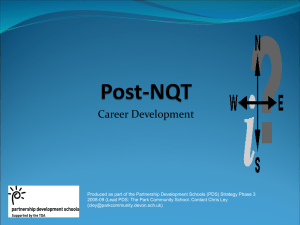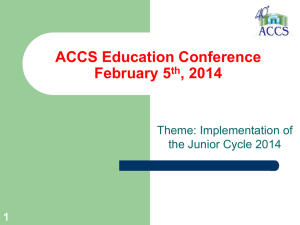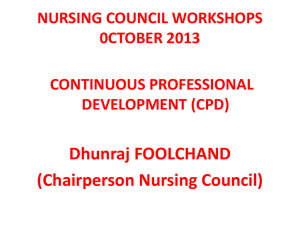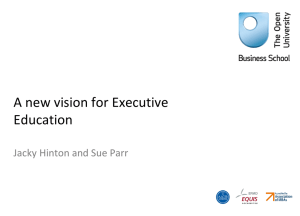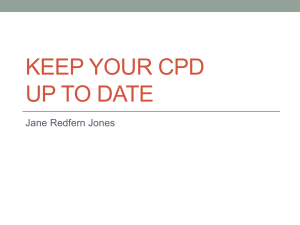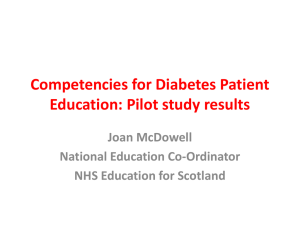Grade 6 MSM I and II - the Howard County Public Schools
advertisement
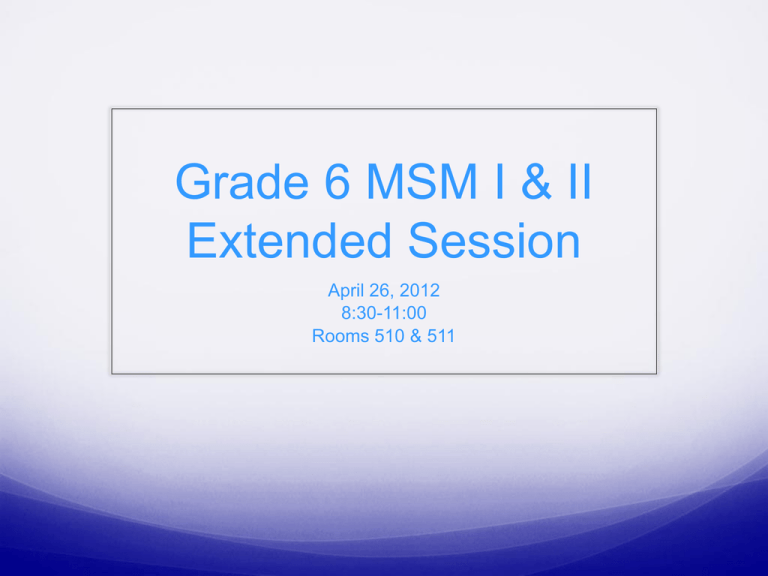
Grade 6 MSM I & II Extended Session April 26, 2012 8:30-11:00 Rooms 510 & 511 Welcome & Introductions Outcomes Participants will: Understand implementation plan for transitioning to Common Core curriculum. Engage in tasks and activities that will be part of MSM I & II curriculum next year. Explore curricular resources webpage designed to support teachers through transition Learn about professional development opportunities to support teachers with new content Beginning implementation of Common Core instruction Standards for Mathematical Practices Writing Standards Full PARCC Full MCCSC Assessment Implementation Implementation New Teacher and Principal Evaluation Instruments PARCC Assessment Field Testing PARCC Timeline SY 2010-11 SY 2011-12 Launch and design phase Development begins SY 2012-13 SY 2013-14 SY 2014-15 Summer 2015 First year pilot/field testing and related research and data collection Second year pilot/field testing and related research and data collection Full administration of PARCC assessments Set achievement levels, including college-ready performance levels 5 Refinements to the PARCC Assessment Design English Language Arts/Literacy and Mathematics, Grades 3-11 Flexible Diagnostic Assessment •Early indicator of student knowledge and skills to •inform instruction, •supports, and PD Summative assessment for accountability Mid-Year Assessment •Performance-based •Emphasis on hard-to•measure standards •Potentially summative Formative assessment Performance-Based Assessment (PBA) • Extended tasks • Applications of concepts and skills Speaking and Listening End-of-Year Assessment •Innovative, computerbased items Understanding the Transition to Common Core Teams of Howard County Math Teachers, ITLs, and MISTs developed the transition plan: Examined cohorts of students Examined what pre-requisite skills would be necessary to be successful for each Common Core course Examined what skills students have currently obtained Determined how best to fill in gaps to meet needs Organized information into the transition plan What is the difference between Grade 6 MSM I and II in 2012-2013? For grade 6 students in 2012-2013, there are not many differences between MSM I and II. For the most part, all students will be following most of Common Core 6 curriculum. Grade 6 MSM II will have a few additional standards from Common Core 7. Grade 7 MSM II looks very different than Grade 6 MSM II. 2012-2013 Essentials • Units organized by domain • Structure of Common Core • Purple bold notes regarding content for 2012-2013 Activity 1: Backsplash Task Image Source: http://www.calfinder.com/blog/kitchen-remodel/hot-trendsin-kitchen-backsplashes/ Activity 1: Backsplash Task The Marshall family is remodeling their kitchen. A creative way to incorporate color is by tiling the backsplash on the wall behind their stove. A standard backsplash is 18 inches by 2 feet. Their son Samuel is very artistic so they ask him to design a tile pattern for the backsplash. The Marshalls only have a few guidelines they are asking Samuel to follow. They want to use small square tiles that are 1 inch by 1 inch. The available colors are red, yellow, green, and blue. Less than 15% of the backsplash should be yellow. For every 1 red tile they want 3 blue tiles. 140 square inches should be green. Create a backsplash design for Samuel to present to his parents. Activity 1 Debrief Share your design with other groups. What mathematical concepts & skills were necessary to complete the task? Look at the Ratios & Proportional Relationships unit— when might a task like this be introduced? Sample Responses Examining the Grade 6 Crosswalk What is a crosswalk document? How should it be used? What does the crosswalk mean for Grade 6? Short Break Mini-Lesson: Ratio Tables What is a ratio table? Why are ratio tables important? When should we use ratio tables? Build a ratio table and use it to answer the question. A person who weighs 160 pounds on Earth will weigh 416 pounds on the planet Jupiter. How much will a person weigh on Jupiter who weighs 120 pounds on earth? At the local college, five out of every eight seniors live in apartments. How many of the 30 senior math majors are likely to live in an apartment? The tax on a purchase of $20 is $1.12. How much tax will there be on a purchase of $45.50? When in Australia you can exchange $4.50 in U.S. dollars for $6 Australian. How much is $17.50 Australian in U.S. dollars? Tasks are adapted from Lamon (1999, p. 183). Activity 2: King of Cakes King of Cakes is making a cake for Skye’s birthday party. On the way to deliver the cake, a piece breaks off. See diagram below. The cake will still be used for the party even though it is missing a piece. King of Cakes will reduce the price based upon the portion that broke off. If the cake was originally priced at $58.25, how much should King of Cakes now charge Skye? Activity 2: King of Cakes Extension Questions: If the original cake served 48 people, about how many people will it now serve? The original cake had 11,040 calories. Approximately how many calories does the broken off piece contain? Activity 2 Debrief Share your solutions with other groups. What mathematical concepts & skills were necessary to complete the task? Look at the Numbers & Operations-Fractions unit— when might a task like this be introduced? Where do I find resources? We have developed websites to help support you as you teach these transition courses. You do not need to join as a member or input any passwords to access the resources!! The main page to visit: http://secondarymathcommoncore.hcpss.wikispaces.ne t/ Next Steps Spring 2012: Lessons/tasks/resources will continue to be developed Summer 2012: Teams will continue to develop resources for courses and Math Seminars Summer 2012: A variety of CPD courses will be offered for math teachers and special educators Fall 2012: Some CPD courses will be offered for math teachers and special educators Summer CPD Offerings All courses will run weekdays from 8 a.m. to 1 p.m. Ratios & Proportional Relationships (1 CPD credit) – June 13-June 15 Number System/Fractions (2 CPD credits) – June 18-22**(M/T 8-3:30) Geometry (1 CPD credit) – June 26-June 28 Statistics & Probability (2 CPD credits) – July 13 July 9- Summer CPD Offerings All courses will run weekdays from 8 a.m. to 1 p.m. Expressions & Equations (2 CPD credits) – July 23-July 27 Functions (1 CPD credit) – July 30-August 1 Teaching Math Seminar (3 CPD credits) – August 10 August 1- Questions? THANK YOU!!!
